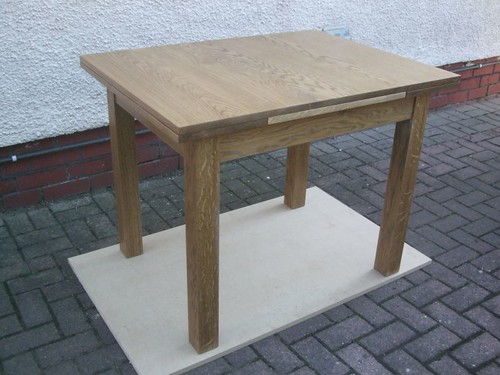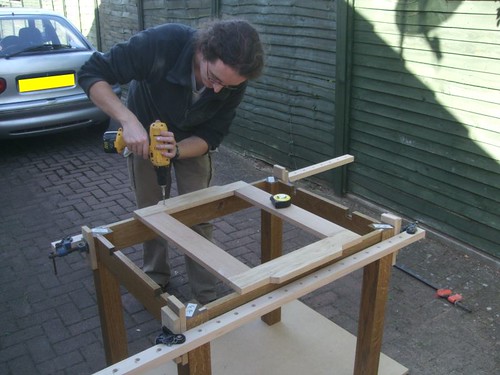OPJ
Established Member
Hi all,
I recently completed a drawer-leaf table for someone in solid English oak, stained to their requirements:

In case you don't know how it works, the two extension leaves slide out from underneath the main top, which is not fixed down to the frame in anyway, so that it can lift and tilt slightly to allow clearance for the leaves.
It has only been in its new home a few days but, already, the top has cupped to the point at which it now sits about 5mm proud of the outer leaves when extended. :?
Here's a shot of the underside of the top:

You can see that I've added strips of self-adhesive felt to prevent scratching and a few 'wide battens' to at least hold the centre flat, with slotted screw holes. Trouble is, I couldn't make these any longer as they'd either foul the frame or the outer leaves. Those end pieces 'locate' over the frame below (as I said before, no solid fixing here).
This next shot shows the under frame:

I'm wondering if there's anything that can be done now to reverse the effects of the top cupping? I've been off Googling for some time but I can't see to find anything on this.
Yes, using quarter-sawn boards probably would have helped. In the beginning, I did have just enough rift- and quarter-sawn oak to make the top but, when I came to plane them up, they were anything but straight! So, I went back to the timber yard and bought some through-sawn boards (they didn't have enough of the other boards to finish).
Moisture content was 13-14% when I bought the oak and, after a few weeks indoors, I got this down to less than 12% in average, which I thought was okay - I know, 10% is regarded as better but, I wanted to get the job done sooner. :roll: After I bought the finished job indoors, I did notice some movement but, it wasn't as severe as 5mm and it did seem to settle down after a week or so. The boards I used finished about 143mm wide. I didn't fancy using narrower boards as it might look "manufactured".
Please, don't mention veneered MDF!! Breadboard ends/end caps wouldn't have worked, I felt, because the extending leaves are only 250mm wide each.
Breadboard ends/end caps wouldn't have worked, I felt, because the extending leaves are only 250mm wide each.
I'm quietly confident that the same will happen here. Chances are that the recipient's home has a different humidity to our and that the oak will settle back down again if given a little time.
Anyone care to add to this? I know that xy mosian has a table like this but, I couldn't see any method to keeping the top flat on his design. Any thoughts would be greatly appreciated.
Thanks for looking,
Olly.
I recently completed a drawer-leaf table for someone in solid English oak, stained to their requirements:

In case you don't know how it works, the two extension leaves slide out from underneath the main top, which is not fixed down to the frame in anyway, so that it can lift and tilt slightly to allow clearance for the leaves.
It has only been in its new home a few days but, already, the top has cupped to the point at which it now sits about 5mm proud of the outer leaves when extended. :?
Here's a shot of the underside of the top:

You can see that I've added strips of self-adhesive felt to prevent scratching and a few 'wide battens' to at least hold the centre flat, with slotted screw holes. Trouble is, I couldn't make these any longer as they'd either foul the frame or the outer leaves. Those end pieces 'locate' over the frame below (as I said before, no solid fixing here).
This next shot shows the under frame:

I'm wondering if there's anything that can be done now to reverse the effects of the top cupping? I've been off Googling for some time but I can't see to find anything on this.
Yes, using quarter-sawn boards probably would have helped. In the beginning, I did have just enough rift- and quarter-sawn oak to make the top but, when I came to plane them up, they were anything but straight! So, I went back to the timber yard and bought some through-sawn boards (they didn't have enough of the other boards to finish).
Moisture content was 13-14% when I bought the oak and, after a few weeks indoors, I got this down to less than 12% in average, which I thought was okay - I know, 10% is regarded as better but, I wanted to get the job done sooner. :roll: After I bought the finished job indoors, I did notice some movement but, it wasn't as severe as 5mm and it did seem to settle down after a week or so. The boards I used finished about 143mm wide. I didn't fancy using narrower boards as it might look "manufactured".
Please, don't mention veneered MDF!!
I'm quietly confident that the same will happen here. Chances are that the recipient's home has a different humidity to our and that the oak will settle back down again if given a little time.
Anyone care to add to this? I know that xy mosian has a table like this but, I couldn't see any method to keeping the top flat on his design. Any thoughts would be greatly appreciated.
Thanks for looking,
Olly.
































